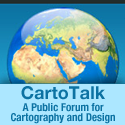Let the Downloads Begin!
Tom and I are pleased to announce the immediate availability of Natural Earth, free vector and raster map data at 1:10m, 1:50m, and 1:110m scales. This is a NACIS and MapGiving co-branded product with assistance from the University of Wisconsin-Madison cartography lab, Florida State University, and others.
Do you have a new theme to contribute to Natural Earth? Great! Please follow these data creation guidelines so it fits in with the rest of the project. Find an error? Log it via the Corrections system.
Why Create Natural Earth?
We have two goals:
First, to give cartographers an off-the shelf solution for creating small-scale world, regional, and country maps. To this end, Natural Earth Vector includes both cultural and physical features and builds on Tom Patterson’s Natural Earth raster data, first introduced in 2005.
Second, we include many features missing from people’s mental map of the world in the hope of improving overall geographic literacy.
Natural Earth Vector solves a problem that many NACIS members face: finding vector data for making publishable-quality small-scale maps. In a time when the web is awash in interactive maps and free, downloadable vector data, such as Digital Chart of the World and VMAP, mapmakers are forced to spend time sifting through a confusing tangle of poorly attributed data. Many cartographers working under tight project deadlines must use manually digitalized bases instead.
Small-scale map datasets of the world do exist, but they have their problems.
For example, most are crudely generalized—Chile’s fjords are a noisy mess, the Svalbard archipelago is a coalesced blob, and Hawaii has disappeared into the Pacific two million years ahead of schedule. They contain few data layers, usually only a coast and country polygons, which may not be in register with each other or modern satellite imagery. The lack of good small-scale map data is not surprising. Large mapping organizations that release public domain data, such as the US Geological Survey, are not mandated to create small-scale map data for a small user community that includes mapmaking shops, publishers, web mappers, academics, and students—in other words, typical NACIS members. Natural Earth Vector fills this oft-overlooked but important niche.
Collaboration
Making Natural Earth Vector is a collaboration involving many volunteer NACIS members. Nathaniel Vaughn Kelso and Tom Patterson began working on the project in late 2008. Following the path of least resistance, the idea was to repurpose existing data that we already had as an integrated world dataset at three map scales.
The 1:50 million and 1:110 million-scale data comes from bases developed by Dick Furno and additional staff at the Washington Post for quick turnaround newspaper mapping— the Washington Post Legal Department kindly granted us permission to use these data. The kernel for the 1:10 million data was a compilation by Patterson for the Physical Map of the World, consisting of coastlines, rivers, lakes, and physical feature labels. Expanding and improving on this foundation has been our chief activity.
The core team grew to include Tanya Buckingham, who coordinates data attributing by Ben Coakley, Kevin McGrath and Sarah Bennett at the University of Wisconsin Cartography Lab; Dick Furno as populated places guru; Nick Springer as the website developer; and Lou Cross as NACIS liaison.
A cast of consultants, many regulars on the Cartotalk.com discussion forum, assisted with place names for various world regions. They include Leo Dillon, Hans van der Maarel, Will Pringle, Craig Molyneaux, Melissa Katz-Moye, Laura McCormick, Scott Zillmer and fellow staff at XNR Mapping.
Data for cartography
We developed a world base map data suitable for making a variety of visually pleasing, well-crafted maps. Unlike other map data intended for scientific analysis or military mapping, Natural Earth Vector is designed to meet the needs of mainstream production cartographers. Maximum flexibility was a goal. For example, Natural Earth Vector comes in ESRI shapefile format, the Geographic projection, and WGS datum, which are de facto standards for vector geodata.
Neatness counts with Natural Earth Vector. The carefully generalized linework maintains consistent, recognizable geographic shapes at 1:10m, 1:50m, and 1:110m scales. As Natural Earth Vector was built from the ground up, you will find that all data layers align precisely with one another. For example, where rivers and country borders are one and the same, the lines are coincident.
Natural Earth Vector, however, is more than just a collection of pretty lines. What lies beneath the surface, the data attributes, is equally important for mapmaking. Most data contain embedded feature names, which are ranked by relative importance. Up to eight rankings per data theme allow easy custom map “mashups” to emphasize your map’s subject while de-emphasizing reference features.
Other attributes facilitate faster map production. For example, width attributes assigned to rivers allow you to create tapered drainages with ease. Assigning different colors to contiguous country polygons is another task made easier thanks to data attribution.
Other key features:
- Vector feature include name attributes and scale ranks – know the Rocky Mountains are larger than the Ozarks.
- Large polygons, such as bathymetric layers, are split for more efficient data handling.
- Projection friendly—vectors precisely match at 180 degrees longitude. Lines contain enough data points for smooth bending in conic projections, but not so many that processing speed suffers.
- Raster data includes grayscale-shaded relief and cross-blended hypsometric tints derived from the latest NASA SRTM Plus elevation data and tailored to register with Natural Earth Vector.
- Optimized for use in web mapping applications, such as Google, Yahoo, and OpenStreetMaps with built-in scale attributes to direct features to be shown at different tile zoom levels.
Data development
Since Natural Earth Vector is for visual mapmaking, we prepared the base layers in Adobe Illustrator in conjunction MAPublisher import and export filters. Illustrator offered us flexible tools for editing lines and polygons, organizing data on layers, and the ability to inspect the final data in a map-like form. A variety of third-party plug-in filters and scripts, some written by Kelso, were essential for linework generalization and other tasks.
World Data Bank 2 was the primary vector data source that required significant modifications. For example, we found that the entire west coast of the United States was about seven miles west of its true position and adjusted it accordingly. Slight adjustments to river positions better matched them to shaded relief derived from more satellite data. For Antarctica, we completely abandoned World Data Bank 2. Here, the coast, glaciers, and ice shelves derive from 2003-2004 NASA Mosaic of Antarctica, a MODIS product. We also updated the data to reflect recent ice shelf collapses.
Contributors from around the globe researched additional feature names beyond those original to Patterson’s Physical Map of the World. Attributing the data was performed in ArcGIS by the team at the University of Wisconsin and by Nathaniel Vaughn Kelso at The Washington Post.
Future activity
We regard the initial release of Natural Earth Vector as a starter dataset that will see periodic updates. With any project as complex as this, flaws and omissions are bound to emerge, requiring our attention. One proposal is to form a Natural Earth map data committee that will incorporate information from users, perhaps using a Wiki model, for coordinating updates. Rivers, lakes, cities, and first order admin are components still in need of refinement. Possible data for future updates include transportation (roads and railroads), time zones, and terrestrial hypsography.
If you have ideas for Natural Earth or
want to show off how you’re using the data,
please drop us a line.
Nathaniel Vaughn Kelso
nathaniel@kelsocartography.com
Tom Patterson
mtmaps@verizon.net














Thank you for this excellent dataset and especially for the generous license. As a shareware author, not having to try figure out what exactly a viral or restricted license will require of my software and of its end users is a huge benefit.
Thank you, thank you, thank you.
You guys are so awesome I can hardly belief it. I’m a total GIS newbie, and this is just perfect. So much more complete than GSHHS, and so much more manageable than planet.osm. Thank you, thank you, thank you!